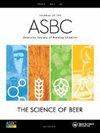熟化温度对小黑麦麦芽品质的影响
IF 1.8
4区 农林科学
Q4 BIOTECHNOLOGY & APPLIED MICROBIOLOGY
Journal of the American Society of Brewing Chemists
Pub Date : 2021-11-03
DOI:10.1080/03610470.2021.1983750
引用次数: 1
摘要
摘要在酿酒工业中,主要原料是大麦芽。Triticale(X.Triticosecale Wittmack)已被评估为基础麦芽。它被认为比大麦具有更大的非平衡力,然而,其固化温度类似于90 °C尚未进行评估,也未对其质量产生影响。本研究的目的是评估小黑麦、小麦、黑麦和大麦基麦芽在70℃下的理化性质 °C,并将它们相互比较以及与其他研究中报道的结果进行比较,以评估小黑麦的酿造潜力。此外,两个温度(80 °C和90 °C)以观察温度升高对小黑麦麦芽理化性质的影响。70 °C小黑麦麦芽的特性与大麦和小麦的特性相似(麦芽提取物和糖化能力)。然而,就可发酵提取物、可溶性蛋白质和粘度而言,麦芽不适合酿造。固化温度提高到80 °C对非糖化能力、提取物百分比和可发酵提取物有负面影响。总的来说,小黑麦作为基础酿造麦芽的潜力高达90 然而,°C的固化温度、可发酵提取物和粘度等参数可能会限制其使用。本文章由计算机程序翻译,如有差异,请以英文原文为准。
Effect of Curing Temperature on Triticale Malt Quality
Abstract In the brewing industry, the main raw material is barley malt. Triticale (X. Triticosecale Wittmack) has been evaluated as a base malt. It is recognized as having greater diastatic power than barley, however, curing temperatures similar to 90 °C have not been evaluated nor has their impact on quality. The objective of this research work was to evaluate the physicochemical properties of triticale, wheat, rye, and barley base malts cured at 70 °C and to compare them with each other and with those reported in other studies, to assess the brewing potential of triticale. Additionally, two temperatures (80 °C and 90 °C) were evaluated to observe the effect of a temperature increase on the physicochemical properties of triticale malt. The 70 °C triticale malt characteristics were shown to resemble those of barley and wheat (malt extract and diastatic power). However, in terms of fermentable extract, soluble protein, and viscosity, the malt was unsuitable for brewing. The increase in the curing temperature to 80 °C had a negative impact on diastatic power, extract percentage, and fermentable extract. Overall, triticale has potential as a base brewing malt up to a 90 °C cure temperature, however, parameters such as fermentable extract and viscosity could limit its use.
求助全文
通过发布文献求助,成功后即可免费获取论文全文。
去求助
来源期刊

Journal of the American Society of Brewing Chemists
工程技术-生物工程与应用微生物
CiteScore
4.00
自引率
20.00%
发文量
41
审稿时长
3 months
期刊介绍:
The Journal of the American Society of Brewing Chemists publishes scientific papers, review articles, and technical reports pertaining to the chemistry, microbiology, and technology of brewing and distilling, as well as the analytical techniques used in the malting, brewing, and distilling industries.
 求助内容:
求助内容: 应助结果提醒方式:
应助结果提醒方式:


